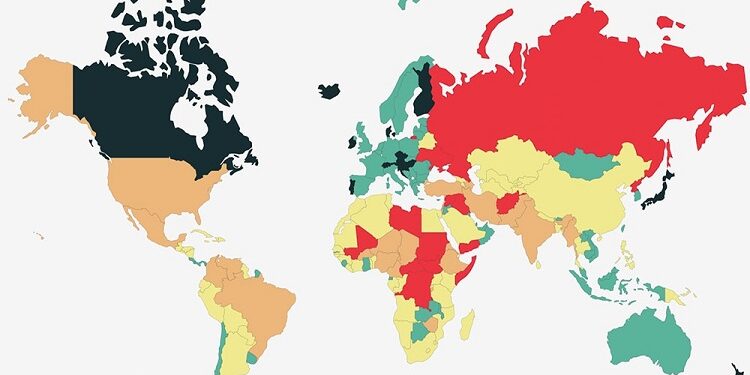The Global Peace Index ranks the safest and most peaceful countries globally. This report is published annually by the Institute for Economics and Peace. It defines itself as “an independent, non-partisan, non-profit organization dedicated to shifting the world’s focus to peace as a positive, achievable and tangible measure of human well-being and progress.” The report researches countries to determine which are the safest and which are the most dangerous.
A total of 163 countries are featured in the GPI report, which ranks each country’s level of safety or danger based on 23 different indicators. The indicators used to compile the GPI include the number of internal and external violent conflicts, level of distrust, political instability, the potential for terrorist acts, number of homicides, and military expenditures as a percentage of GDP. These indicators are grouped into three broad categories: Ongoing International Conflict, Societal Safety and Security, and Militarization, and a score is calculated for each of the 163 nations featured in the report. The lower the score, the higher the nation is ranked in terms of safety.
Top 20 Safest Countries in the World (2022 Global Peace Index—lower is better):
Iceland — 1.107
New Zealand — 1.269
Ireland — 1.288
Denmark — 1.296
Austria — 1.300
Portugal — 1.301
Slovenia — 1.316
Czech Republic — 1.318
Singapore — 1.326
Japan — 1.336
Switzerland — 1.357
Canada — 1.389
Hungary — 1.411
Finland — 1.439
Croatia — 1.440
Germany — 1.462
Norway — 1.465
Malaysia — 1.471
Bhutan — 1.481
Slovakia — 1.499
The United States ranked 129th in the Global Peace Ranking for 2022. Its ranking has fallen every year since 2016, a drop usually attributed to a decrease in life satisfaction, rising political division, and an increasing wealth gap.
Is the World Becoming More or Less Safe?
According to the 2022 GPI report, the world has become less safe over the past 14 years, with average per-country scores deteriorating by 3.2%. The report further notes that safety and peacefulness have decreased in eleven of the past fourteen years. For example, global peace declined by 0.3% overall between the 2021 and 2022 GPI reports. While safety actually improved in 90 countries, it dropped in 71 countries (and remained stable in two), for a net loss.
The 2022 report also stated that declines tend to happen more swiftly and precipitously than do improvements and pointed out that the largest deteriorations occurred in countries in conflicts, such as Russia, Ukraine, Guinea, Burkina Faso, and Haiti. Europe remained the most peaceful region in the world, a position it has held for all 16 years in which the Global Peace Index has existed.
World peace had also decreased between the 2020 and 2021 reports, though by a much smaller 0.07%, with 87 countries improving and 73 deteriorating. The COVID-19 crisis and increasing tension between major world powers were two main causes for the decrease. Stepping back another year to compare the 2020 and 2019 reports, 81 countries grew more peaceful, and 80 reported “deteriorations,” indicating they were less peaceful in 2020 than in 2019. The average country score deteriorated by 0.34%.
The Safest Continent in the World
A majority of the top 25 safest countries are European countries. Most notable are the Nordic countries of Europe. Norway, Sweden, Denmark, Iceland, and Finland are not only among Europe’s safest countries, they are among the top 25 safest countries anywhere on Earth. As such, this region is considered the safest in the world. The homicide rate in this region is 0.8 incidences per 100,000 inhabitants. These five Nordic countries are also in the top 10 happiest countries in the world. The second-most-common region in the top 25 in Asia. Both regions have a homicide rate of about 3 per 100,000 inhabitants.
Qualities the World’s Safest Countries Have in Common
There are some commonalities among the safest countries in the world. For instance, safe countries tend to display high levels of wealth, social welfare, and education. Safe countries typically have effective criminal justice systems and governments that maintain healthy relationships with their citizens.
Profiles of the World’s 10 Safest Countries
1. Iceland
According to the Global Peace Index, Iceland is the safest country in the world for the 14th year. Iceland is a Nordic nation with a relatively small population of 340,000. Iceland has a very low level of crime, which is typically attributed to its high standard of living, small population, strong social attitudes against crime, high level of trust in its well-trained police force, and lack of tension between social and economic classes. Iceland has no military, and the police do not carry firearms with them (only extendable batons and pepper spray). Iceland also has laws to guarantee equality, such as legal same-sex marriage, same-sex adoption, religious freedom, and equal pay for men and women.
2. New Zealand
New Zealand is the second safest country in the world. Like Iceland, New Zealand has a very low crime rate, and violent crime is especially rare. Theft is still worth guarding against, especially in tourist areas (which holds true in every country worldwide) but the overall risk is minimal. Unlike its neighbour Australia, which is known for its dangerous wildlife (box jellyfish, taipan snakes, stonefish, funnel web spiders, and more), New Zealand has no deadly animals. New Zealanders are generally open-minded and have laws in place to prevent the violation of anyone’s freedom of speech or expression. As in Iceland, police in New Zealand do not carry personal firearms.
3. Ireland
Ireland became notably more peaceful in 2021 and vaulted from 11th place to 3rd in the 2022 rankings. Crime is quite low outside of a few city neighbourhoods (and as in any country, one should be wary of pickpockets and scammers in tourist-dense areas), and there is little threat of cultural violence or terrorism. The Irish landscape may pose a greater safety risk than its people—the country’s breathtaking cliffs and winding country roads must be treated with respect, especially during a sudden rainstorm or in areas without cell reception.
4. Denmark
Ranked fourth on the 2022 Global Peace Index, Denmark is another of the safest and happiest countries in the world. Denmark is one of the few countries where people report feeling safe at any time of day or night, even children. Denmark has a high level of equality and a strong sense of common responsibility for social welfare—two qualities contributing to its citizens’ feelings of safety and happiness.
Corruption is rare in Danish business or politics, as honesty and trust are top priorities. While Denmark has a high personal income tax, these taxes fund social programs that ensure everyone receives services and perks that help them live comfortable lives. For example, everyone in Denmark has access to tuition-free higher education and healthcare with no additional fees, and the elderly are provided with at-home care helpers.
5. Austria
Austria ranked as the fifth safest country in the world for 2022. While violent demonstrations in the wake of ongoing social unrest remain a concern, these are relatively easy to avoid, and otherwise, Austria is a very safe country to visit. Serious crimes are uncommon (with the usual caveat to watch for pickpockets and purse-snatchers). Additionally, Austria has been spared any major acts of terrorism in recent years.
6. Portugal
Portugal comes in sixth in the most peaceful countries rankings for 2022. 2014 Portugal was ranked 18th globally and has since made significant strides. Unlike Iceland and New Zealand, Portugal has armed police; however, an increased police presence has decreased the country’s crime rate. In recent years, Portugal has experienced an economic resurgence, decreasing its unemployment rate from over 17% to under 7%. Portugal consistently ranks among the best countries for retirement due in no small part to its high level of safety.
7. Slovenia
One of the former members of Yugoslavia, Slovenia’s high safety ranking can be attributed to its excellent scores in not one, but three separate categories: travel security, medical risks, and road safety. Like many Slavic states, Slovenia installed a democratic government in the mid-1990s and is now focused on improving the quality of life in many areas, including safety and sustainability.
8. Czech Republic
Crime rates in the Czech Republic have steadily decreased over the years, with rates of violent crime in particular dropping significantly. The Czech Republic also has a low incidence of terrorism and natural disasters. Finally, the Czech Republic boasts many clean and efficient hospitals and a state-run health insurance system that offers affordable rates and enables near-universal coverage.
9. Singapore
Singapore ranks ninth on the GPI for 2022. In a Gallup report from 2018, Singapore residents felt the highest sense of personal security and had more positive experiences with law enforcement than did residents of any other country. Singapore has one of the lowest crime rates in the world, possibly due to the severe penalties for even small crimes. The government and police strictly control guns and other firearms, and violent and confrontational crimes are rare in Singapore.
According to the Safe Cities Index from the Economist Intelligence Unit (EIU), Singapore is the second-safest city in the world as a city-state. In 2019, Singapore ranked first for infrastructure and personal security, second for digital security, and eighth for health security.
10. Japan
The tenth-safest country in the world for 2022 is Japan. Japan has been in the top ten countries on the Global Peace Index for 14 years, consistently receiving high marks for low crime rates, minimal internal conflict, and virtually nonexistent political unrest. Japan’s proximity to potentially hostile neighbours China and North Korea could become a threat to its safety at some point but has not thus far.
Japan is known for having limited immigration and limited access to firearms, as the Japanese do not view carrying a gun as an individual right. According to the Safe Cities Index from the Economist Intelligence Unit, Tokyo was considered the safest city in the world in 2019, ranking first in cybersecurity, second in health security, and fourth in infrastructure and personal security.












